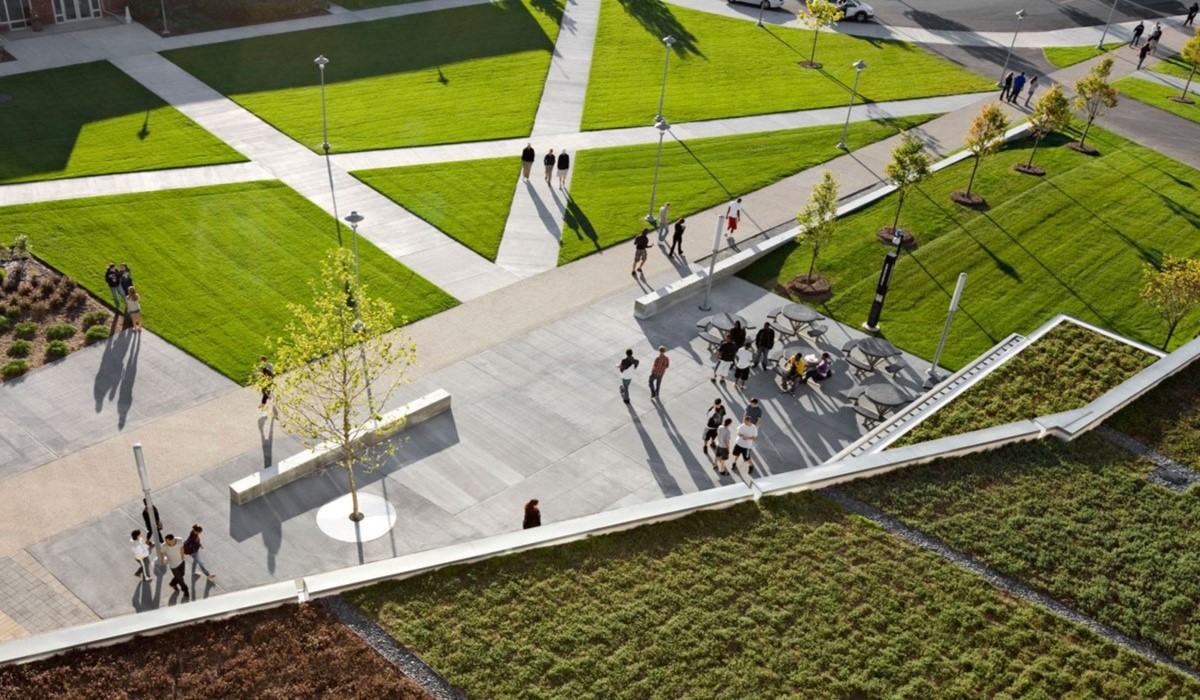Home>diy>Planning & Engineering>What Is The Salary Of A Landscape Architect?


Planning & Engineering
What Is The Salary Of A Landscape Architect?
Modified: August 23, 2024
Discover the average salary of landscape architects in the planning engineering field. Explore career prospects and earning potential in this dynamic profession.
(Many of the links in this article redirect to a specific reviewed product. Your purchase of these products through affiliate links helps to generate commission for Storables.com, at no extra cost. Learn more)
Introduction
Welcome to the fascinating world of landscape architecture! If you have a passion for design, nature, and the environment, this could be the ideal career path for you. As a landscape architect, you have the incredible opportunity to shape and transform outdoor spaces, making them not only aesthetically pleasing but also functional and sustainable.
But before delving into the intricacies of the profession, let’s address one burning question that often comes to mind – what is the salary of a landscape architect? While it’s a crucial consideration for any prospective professional, it’s important to understand that several factors influence a landscape architect’s salary.
In this article, we will explore these factors and shed light on the various elements that can impact the earning potential of a landscape architect. From education and experience requirements to geographic location and job market conditions, we will examine how each aspect affects salary ranges for professionals in this field. Additionally, we will discuss specialization and certifications, types of employers in the industry, benefits and perks, and the job outlook and growth opportunities.
So, let’s embark on this journey together and uncover the different facets of landscape architecture salaries!
Key Takeaways:
- Landscape architects’ salaries are influenced by education, experience, location, specialization, and employer type. Factors such as certifications and benefits also contribute to overall earning potential.
- The field of landscape architecture offers promising job prospects and growth opportunities, driven by sustainable design, urbanization, and technology integration. Professionals can expect competitive salaries and additional benefits.
Factors Affecting Salary
When it comes to determining the salary of a landscape architect, there are several key factors to consider. These factors can have a significant impact on earning potential and can vary from one professional to another. Let’s take a closer look at some of the most influential factors:
- Education and Experience: Education and experience play a crucial role in determining a landscape architect’s salary. Generally, those with higher levels of education, such as a Master’s degree in landscape architecture, tend to earn higher salaries. Additionally, professionals with several years of experience in the field often command higher pay scales compared to those who are just starting their careers.
- Geographic Location: The geographic location of work can have a significant impact on a landscape architect’s salary. Salaries tend to vary from region to region, mainly due to differences in the cost of living and demand for professionals. For example, landscape architects working in major metropolitan areas or affluent regions may earn higher salaries compared to those working in rural or less economically prosperous areas.
- Job Market Conditions: The state of the job market at any given time can influence salary ranges for landscape architects. During periods of economic growth and high demand for construction and development, salaries may be more competitive. Conversely, during economic downturns or recessions, salary levels may be affected, and job opportunities may be more limited.
- Specialization and Certifications: Landscape architects who have specialized expertise or hold relevant certifications in specific areas, such as sustainable design or urban planning, may have an advantage in terms of salary. Specialized skills and certifications demonstrate a higher level of expertise and can warrant higher compensation.
- Types of Employers: The type of employer can also impact a landscape architect’s salary. Design firms, architecture firms, and engineering companies often offer competitive salaries. On the other hand, working for government agencies or nonprofit organizations may provide other benefits but could potentially offer lower salaries compared to the private sector.
It’s important to note that these factors are not mutually exclusive, and their impact can vary based on individual circumstances. So, while one landscape architect may earn a higher salary due to their education and specialization, another architect in a different location may earn more due to the job market conditions.
Understanding these factors can help aspiring landscape architects gauge their earning potential and make informed decisions throughout their career journey. In the next sections, we will dive deeper into the specifics of education and experience requirements, geographic location, specialization, and more.
Education and Experience Requirements
Education and experience are crucial factors that not only shape a landscape architect’s skills and knowledge but also play a significant role in determining their earning potential. Let’s explore these requirements in more detail:
Education: Most landscape architecture positions require at least a Bachelor’s degree in landscape architecture or a related field. These programs typically include coursework in areas such as design, ecology, horticulture, and urban planning. However, for more advanced positions or to stand out in a competitive job market, a Master’s degree in landscape architecture can provide a distinct advantage.
In addition to formal education, landscape architects can also benefit from obtaining personal certifications or licenses. Organizations such as the Council of Landscape Architectural Registration Boards (CLARB) offer the Landscape Architecture Registration Examination (LARE), which assesses an individual’s competency in various aspects of landscape architecture. Becoming a licensed landscape architect can enhance credibility and potentially lead to higher salaries.
Experience: Alongside education, gaining hands-on experience is crucial for career development and improving earning potential. Many landscape architects start their careers through internships or entry-level positions, which provide valuable practical experience and help build a professional portfolio. As professionals gain more experience on diverse projects, take on leadership roles, and showcase their achievements, they become more marketable and may command higher salaries.
Continuing education and professional development are also essential for landscape architects. Staying updated on the latest design trends, sustainable practices, and technological advancements in the field ensures that professionals remain competitive and can contribute to innovative projects. Landscape architecture associations, conferences, and workshops offer opportunities for ongoing learning and networking.
Overall, a combination of formal education, relevant certifications, and hands-on experience is essential for landscape architects looking to advance in their careers and potentially earn higher salaries. It’s important to stay committed to professional growth and continually seek opportunities to expand knowledge and skills.
Next, let’s explore how geographic location and the job market can impact a landscape architect’s salary.
Geographic Location and Job Market
The geographic location in which a landscape architect works can have a significant impact on their salary. Different regions, cities, and countries have varying costs of living, economic conditions, and demand for landscape architecture services. Let’s delve into how these factors influence earning potential:
Cost of Living: The cost of living is a key consideration when evaluating salary ranges for landscape architects. Higher living expenses in certain areas, such as major cities or affluent regions, often translate to higher salaries to offset the increased cost. On the other hand, working in regions with a lower cost of living can mean lower salary ranges. It’s important to research and compare the cost of living in different locations to determine if the salary offered aligns with the local expenses.
Economic Conditions: The state of the local economy and job market also plays a role in the salary landscape for landscape architects. Regions experiencing robust economic growth, driven by construction and development projects, tend to offer higher salaries for professionals in the industry. On the contrary, during economic downturns or in areas with limited development opportunities, salaries may be lower, and competition for jobs may be higher.
Job Demand: The demand for landscape architects can vary across different regions. Urban areas with a focus on sustainable design and green initiatives often have a higher demand for landscape architecture services. These regions may offer more job opportunities and potentially higher salaries due to the demand-supply dynamics. It’s important for landscape architects to consider the job market conditions and seek opportunities in areas where there is strong demand and growth potential.
When considering job opportunities, it’s helpful for landscape architects to research and evaluate the local market conditions in their desired locations. Factors such as population growth, urban development plans, government initiatives, and environmental consciousness can indicate the demand for landscape architecture services in a particular area.
Now that we’ve explored the influence of geographic location and job market on salary, let’s move on to the impact of specialization and certifications in the field of landscape architecture.
Specialization and Certifications
In the field of landscape architecture, specialization and certifications can significantly impact a professional’s salary and career prospects. Let’s delve into how these factors can elevate earning potential:
Specialization: Landscape architecture is a diverse field with various areas of specialization. Some landscape architects focus on residential landscape design, creating beautiful and functional outdoor spaces for homeowners. Others specialize in commercial or public landscape design, working on projects such as parks, campuses, or urban revitalization initiatives. There are also specialists in sustainable design, historic preservation, urban planning, and more.
By specializing in a specific area, landscape architects can position themselves as experts in their field. This expertise can result in higher client demand, increased opportunities, and potentially higher salaries. Clients and employers are often willing to pay a premium for specialized skills and knowledge that can deliver unique and innovative solutions.
Certifications: Obtaining relevant certifications can also enhance a landscape architect’s earning potential. Organizations such as the Leadership in Energy and Environmental Design (LEED) offer certifications specific to sustainable design practices. Becoming a LEED-accredited professional demonstrates expertise in environmentally conscious design and can open doors to higher-paying projects that prioritize sustainability.
Other certifications, such as the Certified Playground Safety Inspector (CPSI) or the Sustainable Sites Initiative (SITES), can showcase specialized knowledge in specific areas. These certifications not only validate expertise but also demonstrate a commitment to ongoing professional development and staying abreast of industry trends.
Landscape architects with specialized skills and certifications bring added value to projects and can command higher salaries. These professionals are often sought after for their in-depth knowledge, ability to navigate complex design challenges, and understanding of industry best practices.
It’s important for landscape architects to carefully consider their interests, passion, and strengths when choosing a specialization. By focusing on an area that aligns with their skills and interests, professionals can carve out a successful niche and potentially achieve higher earning potential.
Next, let’s explore how the type of employer can impact a landscape architect’s salary.
Research the average salary for landscape architects in your specific location, as it can vary greatly depending on the region and level of experience. Websites like Glassdoor and Indeed can provide valuable salary information.
Types of Employers
When it comes to landscape architecture, professionals have the opportunity to work for various types of employers. The type of employer can have a significant impact on a landscape architect’s salary and overall compensation package. Here are some common types of employers in the industry:
- Design Firms: Design firms specializing in landscape architecture are a popular choice for many landscape architects. These firms focus primarily on the design and planning of outdoor spaces, ranging from residential gardens to large-scale commercial projects. Design firms often offer competitive salaries and benefits packages, as well as opportunities to work on diverse and exciting projects.
- Architecture Firms: Landscape architects can also find employment in architecture firms, collaborating with architects and other design professionals. This type of employer allows landscape architects to be involved in multidisciplinary projects and work closely with teams to create cohesive designs. Salaries in architecture firms can vary, but many offer competitive compensation and the chance to work on high-profile projects.
- Engineering Companies: Landscape architects who have a strong interest in incorporating sustainable design principles and working on infrastructure projects may find opportunities in engineering companies. These firms often specialize in civil engineering, environmental consulting, or land development. Salaries in this sector can be competitive, particularly for those with expertise in stormwater management, site planning, and green infrastructure design.
- Government Agencies: Landscape architects employed by government agencies, such as city planning departments, parks and recreation departments, or environmental agencies, play a vital role in shaping public spaces. While salaries in the public sector may not always be as high as in the private sector, these positions often offer stability, benefits, and the satisfaction of contributing to the community.
- Nonprofit Organizations: Some landscape architects choose to work for nonprofit organizations focused on environmental advocacy, conservation, or community development. While salaries in the nonprofit sector may be lower compared to other industries, these positions often offer unique experiences, the chance to work on meaningful projects, and a strong sense of purpose.
It’s worth noting that the compensation and benefits offered can vary within each type of employer, depending on factors such as the size of the organization, location, project budget, and the individual’s experience and qualifications. Additionally, some landscape architects may choose to work as independent consultants, offering their services directly to clients. This path can provide flexibility in terms of project selection and potentially higher earning potential.
When considering job opportunities, landscape architects should carefully evaluate the type of employer and the overall compensation package, including salary, benefits, professional development opportunities, work-life balance, and potential for career advancement.
Now that we’ve explored the various types of employers, let’s move on to understanding the salary range for landscape architects.
Salary Range for Landscape Architects
The salary range for landscape architects can vary depending on factors such as education, experience, location, specialization, and type of employer. While it’s difficult to pinpoint an exact figure, we can provide a general overview of the salary ranges in the field.
According to the U.S. Bureau of Labor Statistics, the median annual wage for landscape architects in 2020 was $73,160. The lowest 10 percent of professionals earned less than $43,860, while the highest 10 percent earned more than $119,360. It’s important to note that these figures represent median values and can vary based on individual circumstances.
Salaries for landscape architects often increase with higher levels of education. Those with a Bachelor’s degree typically start at the lower end of the salary range, while those with a Master’s degree or higher can expect higher starting salaries. Additionally, obtaining relevant certifications and continuing education can contribute to salary growth.
Geographic location is a significant factor that influences salary ranges. Major metropolitan areas with a higher cost of living and strong demand for landscape architecture services tend to offer higher salaries. For example, landscape architects working in cities like New York, San Francisco, or Los Angeles may command higher salaries compared to those in smaller towns or rural areas.
The type of employer also plays a role in salary ranges. Working for design or architecture firms, engineering companies, and certain government agencies generally offers more competitive salaries compared to nonprofit organizations or self-employment. However, it’s important to consider the overall compensation package, including benefits and opportunities for professional growth, when evaluating job offers.
Finally, specialization within the field of landscape architecture can impact salaries. Landscape architects with expertise in niche areas such as sustainable design, urban planning, or historic preservation may have an advantage in terms of salary and career opportunities. Their specialized knowledge and skills are often in high demand, allowing them to command higher compensation.
It’s essential to research and consider multiple factors when assessing salary ranges in landscape architecture. By understanding the industry standards, evaluating individual qualifications and experiences, and considering personal goals and preferences, professionals can gain a clearer understanding of their earning potential in the field.
Next, let’s explore the benefits and perks that landscape architects may enjoy in addition to their salaries.
Benefits and Perks
Aside from the salary, landscape architects often enjoy additional benefits and perks as part of their overall compensation packages. These benefits can vary depending on the employer and individual circumstances but may include the following:
- Health and Retirement Benefits: Many employers offer health insurance coverage, including medical, dental, and vision plans. Landscape architects may also have access to retirement savings plans, such as 401(k) or pension plans, to help secure their financial future.
- Paid Time Off: Paid time off (PTO) is a common benefit that allows landscape architects to take time off for vacations, personal days, or illness. Employers may offer a certain number of vacation days, holidays, and sick leave, providing the opportunity for work-life balance and time to recharge.
- Flexible Work Arrangements: Some employers offer flexible work arrangements, such as remote work options or flexible hours. This flexibility allows landscape architects to have a better work-life balance and may provide added convenience and reduced commuting time.
- Professional Development: Employers recognize the importance of ongoing learning and professional growth. They may provide opportunities for landscape architects to attend conferences, workshops, and seminars to expand their knowledge and skills. Some employers may also offer tuition reimbursement for further education.
- Employee Assistance Programs: Employee assistance programs (EAPs) provide resources and support for various aspects of an employee’s well-being. This can include counseling services, financial planning assistance, and access to educational resources.
- Bonuses and Performance Incentives: Some employers offer performance-based bonuses or incentives to reward exceptional work and achievement of specific goals. These additional financial rewards can motivate landscape architects and further enhance their earning potential.
- Professional Memberships: Employers may cover the costs of professional memberships in landscape architecture associations or organizations. These memberships provide access to networking events, industry publications, and resources for professional development.
Keep in mind that the availability of these benefits and perks can vary depending on the employer and individual circumstances. When evaluating job opportunities, landscape architects should consider not only the base salary but also the overall compensation package, including these additional benefits and perks.
Now that we’ve explored the various benefits and perks that landscape architects may enjoy, let’s move on to discussing the job outlook and growth opportunities in the field.
Job Outlook and Growth Opportunities
The job outlook for landscape architects is generally positive, with opportunities for growth and advancement in the field. Here are some key factors to consider when evaluating job prospects in landscape architecture:
Growing Demand: As society becomes more aware of the importance of sustainable and environmentally friendly design, the demand for landscape architects is projected to grow. The need for professionals who can design innovative outdoor spaces, integrate green infrastructure, and create sustainable landscapes is increasing in both public and private sectors.
Urbanization and Development: The ongoing process of urbanization, coupled with the need for smart and aesthetically pleasing urban environments, presents great opportunities for landscape architects. Rapid urban growth and the revitalization of existing urban spaces contribute to the demand for talented professionals who can transform cities and create livable and sustainable communities.
Climate Change Adaptation: Climate change and its impact on the environment require landscape architects to address issues such as stormwater management, heat island mitigation, and biodiversity conservation. These challenges present opportunities for landscape architects to contribute their expertise in creating resilient and adaptable landscapes that can mitigate the effects of climate change.
Technology Integration: Advances in technology, such as computer-aided design (CAD) software, Geographic Information Systems (GIS), and 3D visualization tools, have revolutionized the landscape architecture profession. As technologies continue to advance, landscape architects who stay updated with the latest tools and techniques will have a competitive edge, leading to more job opportunities and growth potential.
Sustainable Design: The growing emphasis on sustainability and green design principles offers landscape architects significant growth opportunities. Professionals who specialize in sustainable design, green infrastructure, and environmentally responsible practices will be sought after to tackle projects focused on reducing carbon footprints, conserving resources, and promoting ecological resilience.
International Opportunities: Landscape architects have the option to explore job opportunities both domestically and internationally. The demand for landscape architecture professionals exists worldwide, particularly in regions experiencing rapid urbanization and environmental challenges. This opens doors to exciting projects and the chance to work in diverse cultural and environmental contexts.
Overall, the field of landscape architecture offers promising job prospects and growth opportunities. By staying abreast of industry trends, continuously developing skills, and positioning oneself as a specialist in emerging areas, landscape architects can thrive and contribute to the creation of sustainable and beautiful outdoor spaces.
As we conclude our exploration of the job outlook and growth opportunities, it’s evident that the landscape architecture profession holds immense potential for professionals seeking a fulfilling and rewarding career.
Conclusion
In conclusion, the salary of a landscape architect is influenced by various factors, including education and experience, geographic location, specialization, and type of employer. Landscape architects with higher levels of education, such as a Master’s degree, tend to earn higher salaries. The geographic location of work can also impact salary ranges, with major metropolitan areas often offering higher compensation. Specialization in areas such as sustainable design or historic preservation, along with relevant certifications, can contribute to increased earning potential.
When considering job opportunities, landscape architects should carefully evaluate the type of employer, as each offers different salary ranges and benefits. Design firms, architecture firms, engineering companies, government agencies, and nonprofit organizations are common employers in the field, each with its own unique compensation packages.
While salary is an important aspect, landscape architects also enjoy additional benefits and perks such as health insurance, retirement plans, paid time off, flexible work arrangements, and professional development opportunities. These benefits contribute to overall job satisfaction and work-life balance.
The job outlook for landscape architects is generally positive, with growing demand due to increasing awareness of sustainable design practices, urbanization, and climate change adaptation. Advancements in technology and the integration of innovative design tools further contribute to job growth and opportunities for professionals in the field.
In summary, a career in landscape architecture offers an exciting blend of design, creativity, and environmental stewardship. By considering the various factors that influence salary, assessing the benefits and perks offered, and exploring the growth opportunities in the field, landscape architects can build a rewarding career that aligns with their passion for creating sustainable and aesthetically pleasing outdoor spaces.
So, if you are considering a career in landscape architecture, be prepared to embark on a fulfilling journey where you can contribute to the improvement of our built environment while enjoying competitive salaries, benefits, and the satisfaction of creating spaces that enrich lives.
Frequently Asked Questions about What Is The Salary Of A Landscape Architect?
Was this page helpful?
At Storables.com, we guarantee accurate and reliable information. Our content, validated by Expert Board Contributors, is crafted following stringent Editorial Policies. We're committed to providing you with well-researched, expert-backed insights for all your informational needs.














0 thoughts on “What Is The Salary Of A Landscape Architect?”